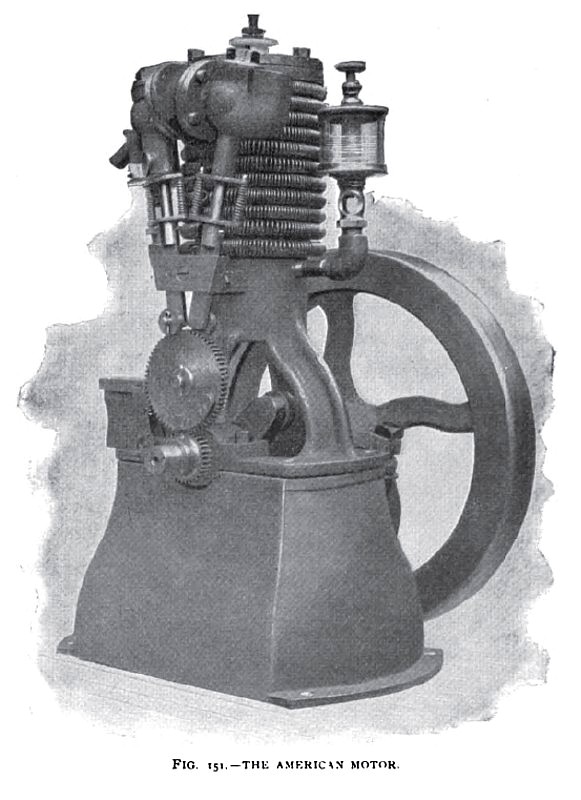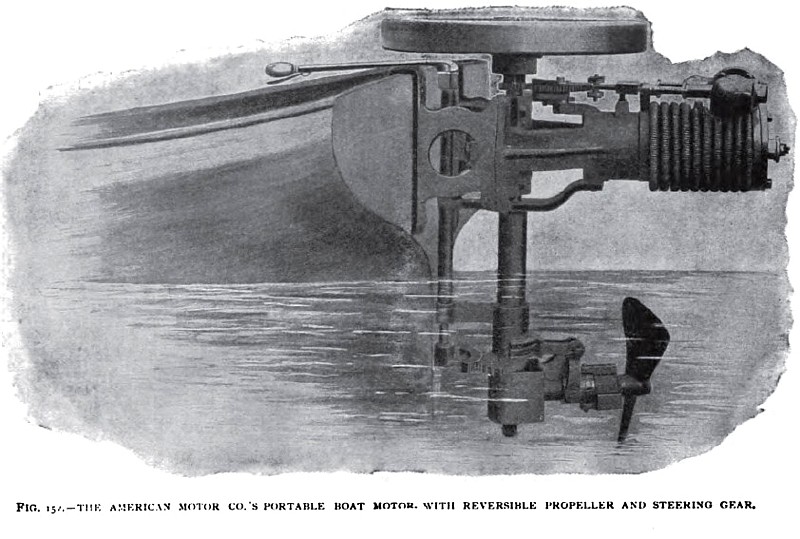|
Title: |
1898 Arrticle-American Motor Co., Gas Engines |
|
Source: |
Gas, Gasoline and Oil Vapor Engines, 1898 pgs 222-223 |
|
Insert Date: |
10/23/2012 5:12:43 PM |
The American Motor
This is a high-speed gas and gasoline motor made by the American Motor Company for stationary and marine service. It is as yet built in two sizes, of from 1 to 2 H. P. respectively, according to the fuel used, and of the style shown in Fig. 150; also as a twin engine with two cranks on one shaft of 2 to 4 H.p. Speed from 400 to 600 revolutions per minute. These engines are extremely light for their power, owing to the displacement of a water-jacket by the use of a coiled wire wrapping on the single-wall cylinder, which produces an extended air-cooling surface and dispenses with the use of water for cooling the cylinder.
These engines are of the four-cycle compression type, with but two valves, both with positive lift by push-rods and rollers with tension springs; the push rods are operated by cams, one on each side of the reducing-gear wheel. The gas or vapor enters through a graduating valve at the left in the cut, and the air through an opening under the inlet valve, also seen in the cut (Fig. 151). The insulated electrodes enter through the cylinder head, and are flashed by an induction or Ruhmkorff coil and dry battery. For stationary engines a- governor is provided. Weight of the No. 1, 50 lbs., including fly-wheel without base; No. 2, 75 lbs., including fly-wheel without base —being the lightest gas or gasoline engines in the trade for their power.
The adaptation of this engine in its portable form to the propulsion of small boats is a unique piece of mechanism. This adaptation is shown in Fig. 152, as applied to an ordinary rowboat of from 12 to 16 feet in length. By the hooked frame it is quickly dropped into place on the stern-board and clamped, the connection made with a carburetor at any convenient place in the boat with flexible tubing, and the boat is ready to start.
The motion of the vertical shaft inside the casing, seen at the water surface in the cut, is transferred to the propeller shaft by a bevel gear inside the rectangular case at the bottom. The blades of the propeller are rotated for stopping or backing by the movement of the grooved sleeve on the shaft casing and the bell crank, which transmits a reverse motion to the propeller blades. The lateral motion of the propeller and shaft for steering is made through the sector gear, and all the operations of steering, forward, stop, or backing, are made by two motions of the helm: a lateral motion for steering as usual for boats, and a vertical motion for changing the angle of the propeller blades. The cylinders of these little engines are inches in diameter, four-inch stroke, and make from 400 to 600 revolutions per minute, with a boat speed of from six to eight miles per hour. |
|
 1898 American Motor Co., Gas Engine
1898 American Motor Co., Gas Engine
 1898 American Motor Co., Marine Gas Engine
1898 American Motor Co., Marine Gas Engine
|
|